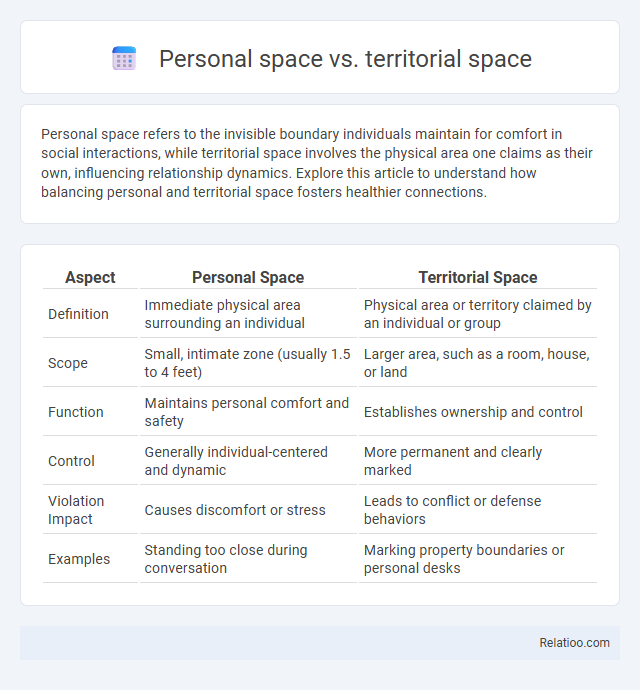Personal space refers to the invisible boundary individuals maintain for comfort in social interactions, while territorial space involves the physical area one claims as their own, influencing relationship dynamics. Explore this article to understand how balancing personal and territorial space fosters healthier connections.
Table of Comparison
| Aspect | Personal Space | Territorial Space |
|---|---|---|
| Definition | Immediate physical area surrounding an individual | Physical area or territory claimed by an individual or group |
| Scope | Small, intimate zone (usually 1.5 to 4 feet) | Larger area, such as a room, house, or land |
| Function | Maintains personal comfort and safety | Establishes ownership and control |
| Control | Generally individual-centered and dynamic | More permanent and clearly marked |
| Violation Impact | Causes discomfort or stress | Leads to conflict or defense behaviors |
| Examples | Standing too close during conversation | Marking property boundaries or personal desks |
Understanding Personal Space
Personal space refers to the invisible boundary individuals maintain to feel comfortable and secure during social interactions, typically varying between 18 inches to 4 feet depending on relationship and context. Territorial space involves areas people claim and defend as their own, such as homes or workspaces, playing a key role in feelings of ownership and control. Understanding your personal space helps to navigate social cues effectively, reduce discomfort, and foster positive communication by respecting others' need for physical distance.
Defining Territorial Space
Territorial space refers to the physical area that an individual or group claims and defends as their own, often marked by boundaries such as fences, signs, or personal belongings. Unlike personal space, which is an invisible bubble around a person reflecting comfort levels during social interactions, territorial space represents a fixed environment tied to ownership and control. Managing territorial space involves cultural norms and social rules that dictate acceptable intrusion and protect privacy and security.
Key Differences Between Personal and Territorial Space
Personal space refers to the invisible bubble individuals maintain around themselves to feel comfortable, typically varying based on relationships and cultural norms. Territorial space involves a defined area or property one claims as their own, often marked by possessions or boundaries to prevent intrusion. Understanding the key differences between personal and territorial space helps you respect others' comfort by recognizing when proximity feels intimate versus invasive.
The Psychology Behind Spatial Boundaries
Personal space, territorial space, and physical distance represent distinct spatial boundaries shaped by psychological needs for comfort, control, and security. Personal space refers to the invisible bubble individuals maintain around themselves to feel safe, while territorial space involves ownership over a defined area that influences social interactions and behavior. Understanding these psychological spatial boundaries helps you navigate social settings effectively, respecting others' comfort zones and reducing conflicts.
Cultural Influences on Space Perception
Cultural influences profoundly shape perceptions of personal space, territorial space, and physical distance, affecting how individuals interpret proximity during social interactions. In high-contact cultures, close physical distance is a norm, whereas low-contact cultures prefer larger personal and territorial boundaries to maintain comfort and respect. Understanding these cultural variations helps you navigate social settings more effectively by respecting diverse spatial norms.
Personal Space in Social Interactions
Personal space in social interactions refers to the invisible boundary individuals maintain around themselves to feel comfortable and secure, usually ranging from 18 inches to 4 feet depending on the relationship and context. Unlike territorial space, which involves a fixed area controlled by an individual, personal space adapts dynamically based on social cues, cultural norms, and emotional states. Understanding and respecting Your personal space can significantly improve communication and reduce discomfort or conflict in social settings.
Territorial Space in Public and Private Environments
Territorial space refers to the area individuals claim in public and private environments to assert ownership and control. In public spaces, territorial markers like seating choices or personal belongings signal boundaries, while in private settings, walls and furniture arrangements reinforce one's domain. Understanding how your territorial space influences social interactions helps maintain comfort and respect across different environments.
Violations and Respect of Spatial Boundaries
Violations of personal space often trigger discomfort and stress as individuals feel their intimate boundaries are breached, whereas territorial space infringements can provoke defensive or aggressive behaviors due to perceived threats to ownership or control. Respecting physical distance in social and professional settings fosters trust and comfort, reducing anxiety linked to overcrowding or unwanted proximity. Understanding and honoring these spatial boundaries enhances communication effectiveness and interpersonal relationships across diverse cultural contexts.
Impact of Space on Relationships
Personal space, territorial space, and physical distance each influence the dynamics of your relationships by defining comfort levels and boundaries between individuals. Personal space refers to the immediate area surrounding you that, when encroached upon, can cause discomfort, while territorial space involves the spaces you claim and control, such as your home or office, impacting feelings of security and autonomy. Physical distance, shaped by cultural norms and personal preferences, affects communication and intimacy, making it essential to respect these spatial boundaries to maintain healthy interpersonal connections.
Strategies for Managing Personal and Territorial Space
Effective strategies for managing personal and territorial space include establishing clear boundaries, using nonverbal cues such as body orientation and eye contact, and communicating preferences assertively to maintain comfort and respect. In personal space management, adjusting proximity based on cultural norms and situational context helps prevent discomfort or intrusion. Territorial space can be controlled through physical markers, such as personal belongings or designated areas, reinforcing ownership and reducing conflicts.

Infographic: Personal space vs Territorial space
 relatioo.com
relatioo.com